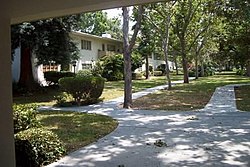Baldwin Hills Village
|
Baldwin Hills Village
|
|

Village Green, 2006
|
|
| Location | Los Angeles, California |
|---|---|
| Coordinates | 34°01′11″N 118°21′39″W / 34.01972°N 118.36083°WCoordinates: 34°01′11″N 118°21′39″W / 34.01972°N 118.36083°W |
| Built | 1942 |
| Architect | Clarence Stein; Reginald D. Johnson; et al. |
| Architectural style | Other, Modern Movement |
| NRHP Reference # | 93000269 |
| LAHCM # | 174 |
| Significant dates | |
| Added to NRHP | April 1, 1993 |
| Designated NHLD | January 3, 2001 |
| Designated LAHCM | May 4, 1977 |
Village Green, originally named Baldwin Hills Village, is a condominium complex in the Crenshaw District, and a neighborhood at the foot of the Baldwin Hills, within the city of Los Angeles, California.
It is located between Rodeo Road and Coliseum Street, and between Hauser Blvd. and slightly west of La Brea Avenue, in the northwestern South Los Angeles region. The Baldwin Village neighborhood is just to the east of Village Green and La Brea Avenue.
The Baldwin Hills Village complex was built in 1942 as one of the most ambitiously planned communities in Los Angeles at the time, with 627 apartments grouped in buildings on a very large landscaped site. The Modernist Garden city style complex, which encompassed 627 units, was designed by architect Reginald D. Johnson, consulting architect Clarence S. Stein, with the firm of Wilson, Merill & Alexander, and landscape architect Fred Barlow, Jr. in the "" style. The units seldom have more than two bedrooms, and tend to attract seniors and younger professionals as residents. As one of the first such establishments, the Village Green was also designed with the requirements of car-owners in mind.
As Baldwin Hills Village, Village Green was declared a Los Angeles Historic-Cultural Monuments in 1977, listed on the National Register of Historic Places in 1993, and a National Historic Landmark historic district in 2001.
...
Wikipedia



